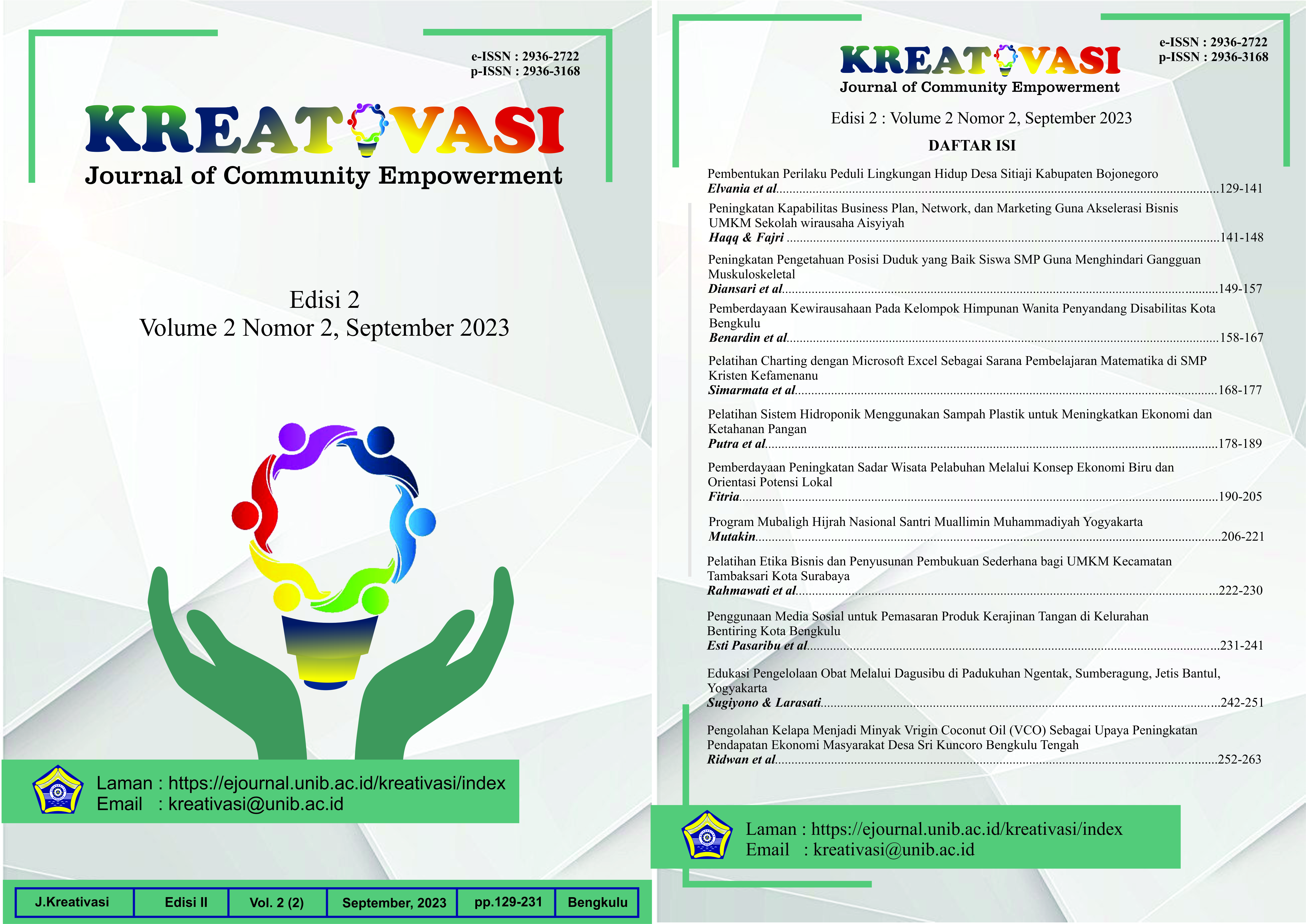Main Article Content
Abstract
This service program focuses on the importance of literacy and numeracy in the industrial era 4.0 and the efforts made in Indonesia to improve these skills. Literacy is considered a basic need in meeting the needs of human life and developed countries have recognized the importance of literacy as a human right. However, in Indonesia, students' literacy and numeracy abilities are still lacking and have even decreased in recent years. Factors such as the lack of strengthening literacy, the impact of the Covid-19 pandemic, and sub-optimal distance learning have led to a decline in students' abilities. Therefore, the Indonesian government has set literacy as a priority program and strengthened the role of LP Maarif in developing literacy and numeracy. LP Maarif is trying to provide library facilities, develop an integrated curriculum, and provide training to teachers to become agents of literacy development. Hopefully, this effort can help elementary school students build their intelligence and improve their critical, strategic and solutive thinking skills in facing future challenges.
Keywords
Article Details
Copyright (c) 2023 Fahmy Akbar Idries, Febriani Wahyusari N , Foster Ikhsan, Budi Sutiono PN

This work is licensed under a Creative Commons Attribution-ShareAlike 4.0 International License.
- This statement is a commitment from the author, to respect copyright, both in terms of quoting the work of others, as well as in the use of journal content.
- If needed, the author can send a statement of authenticity of the manuscript. With the receipt of an article by the Editor of Kreativasi - Journal of Community Empowerment, the article submitted has the copyright held by Kreativasi - Journal of Community Empowerment:
- Kreativasi - Journal of Community Empowerment has the right to reproduce and distribute articles that have been published in journals.
- The author is not permitted to publish the same article that has been published in this journal.
References
- Agung, A., Agung, G., Angga Dewi, P. Y., & Dantes, K. R. (2020). Perencanaan Pembelajaran Pendidikan Anak Usia Dini Dalam Menghadapi Tantangan Revolusi Industri 4.0. Prosiding Seminar Nasional Dharma Acarya, 1(3), 321–328. https://doi.org/10.2991/ICOIE-18.2019.55
- Sudrajat, J., & Tri. (2020). Kompetensi Guru di Masa Pandemi covid-19. Jurnal Riset Ekonomi Dan Bisnis, 13(2), 100–110. https://doi.org/10.26623/JREB.V13I2.2434
- Narut, Y. F., Supardi, K., Pgsd, P., St, S., Paulus, J. J. A., & Yani, R.-F. (2019). Literasi Sains Peserta Didik dalam Pembelajaran IPA di Indonesia. JIPD (Jurnal Inovasi Pendidikan Dasar), 3(1), 61–69. https://jurnal.unikastpaulus.ac.id/index.php/jipd/article/view/214
- Perdana, R., & Suswandari, M. (2021). Literasi Numerasi dalam Pembelajaran Tematik Siswa Kelas Atas Sekolah Dasar. Absis: Mathematics Education Journal, 3(1), 9–15. https://doi.org/10.32585/ABSIS.V3I1.1385
- Prawiyogi, A. G., Purwanugraha, A., Fakhry, G., & Firmansyah, M. (2020). Efektivitas Pembelajaran Jarak Jauh Terhadap Pembelajaran Siswa di SDIT Cendikia Purwakarta. Jurnal Pendidikan Dasar, 11(1), 94–101. https://doi.org/10.21009/JPD.011.10
- Ramandanu, F. (2019). Gerakan Literasi Sekolah (GLS) Melalui Pemanfaatan Sudut Baca Kelas Sebagai Sarana Alternatif Penumbuhan minat Baca Siswa. Mimbar Ilmu, 24(1), 10–19. https://doi.org/10.23887/MI.V24I1.17405
- Salim, I., Al Hidayah, R., Martono, H., & Hj Sulistyarini, Mp. (2019). Analisis Penerapan Literasi Membaca Pada Pembelajaran Sosiologi di SMAN 1 Pulau Maya. Jurnal Pendidikan Dan Pembelajaran Khatulistiwa (JPPK), 8(2). https://doi.org/10.26418/JPPK.V8I2.31507
- Septianti, N., & Afiani, R. (2020). Pentingnya Memahami Karakteristik Siswa Sekolah Dasar di SDN Cikokol 2. AS-SABIQUN, 2(1), 7–17. https://doi.org/10.36088/ASSABIQUN.V2I1.611
References
Agung, A., Agung, G., Angga Dewi, P. Y., & Dantes, K. R. (2020). Perencanaan Pembelajaran Pendidikan Anak Usia Dini Dalam Menghadapi Tantangan Revolusi Industri 4.0. Prosiding Seminar Nasional Dharma Acarya, 1(3), 321–328. https://doi.org/10.2991/ICOIE-18.2019.55
Sudrajat, J., & Tri. (2020). Kompetensi Guru di Masa Pandemi covid-19. Jurnal Riset Ekonomi Dan Bisnis, 13(2), 100–110. https://doi.org/10.26623/JREB.V13I2.2434
Narut, Y. F., Supardi, K., Pgsd, P., St, S., Paulus, J. J. A., & Yani, R.-F. (2019). Literasi Sains Peserta Didik dalam Pembelajaran IPA di Indonesia. JIPD (Jurnal Inovasi Pendidikan Dasar), 3(1), 61–69. https://jurnal.unikastpaulus.ac.id/index.php/jipd/article/view/214
Perdana, R., & Suswandari, M. (2021). Literasi Numerasi dalam Pembelajaran Tematik Siswa Kelas Atas Sekolah Dasar. Absis: Mathematics Education Journal, 3(1), 9–15. https://doi.org/10.32585/ABSIS.V3I1.1385
Prawiyogi, A. G., Purwanugraha, A., Fakhry, G., & Firmansyah, M. (2020). Efektivitas Pembelajaran Jarak Jauh Terhadap Pembelajaran Siswa di SDIT Cendikia Purwakarta. Jurnal Pendidikan Dasar, 11(1), 94–101. https://doi.org/10.21009/JPD.011.10
Ramandanu, F. (2019). Gerakan Literasi Sekolah (GLS) Melalui Pemanfaatan Sudut Baca Kelas Sebagai Sarana Alternatif Penumbuhan minat Baca Siswa. Mimbar Ilmu, 24(1), 10–19. https://doi.org/10.23887/MI.V24I1.17405
Salim, I., Al Hidayah, R., Martono, H., & Hj Sulistyarini, Mp. (2019). Analisis Penerapan Literasi Membaca Pada Pembelajaran Sosiologi di SMAN 1 Pulau Maya. Jurnal Pendidikan Dan Pembelajaran Khatulistiwa (JPPK), 8(2). https://doi.org/10.26418/JPPK.V8I2.31507
Septianti, N., & Afiani, R. (2020). Pentingnya Memahami Karakteristik Siswa Sekolah Dasar di SDN Cikokol 2. AS-SABIQUN, 2(1), 7–17. https://doi.org/10.36088/ASSABIQUN.V2I1.611
